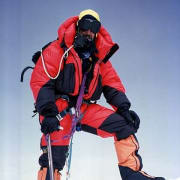Remembering The First Climbers to Summit an 8,000-meter Peak

Legendary Alpinist Louis Lachenal
French alpinist Louis Lachenal died in a crevasse in the Alps 69 years ago today. Lachenal was one of the first two mountaineers in history to summit an 8,000m peak - Annapurna I in 1950. Fourteen mountains in the world rise above 8,000-meters (26,247 feet). The International Mountaineering and Climbing Federation (“UIAA”) recognizes only these peaks as meeting the 8,000-meter requirement, and as ‘sufficiently independent of neighboring peaks’. All 14 of the 8,000-meters reside in the Himalayan and Karakorum mountain ranges in Asia and reach into the rarefied and dangerous strata known as the ‘Death Zone’.
Legendary Italian climber, Reinhold Messner, became the first person to scale all of these prestigious mountains in 1986 without the aid of supplemental oxygen. His historic feat, chased by ambitious mountaineers ever since, set the high-water mark in mountaineering success. But the honor of summiting one of these giant 8,000-meter mountains for the first time belongs to French climbers Louis Lachenal and Maurice Herzog in 1950, three years before Sir Edmund Hillary and Tenzing Norgay scaled Mt. Everest for the first time.
Kris Annapurna wrote an Article for ExplorersWeb on the historic climbing figure. Lachenal was born on July 17, 1921, in southeastern France. His love of mountaineering started in his early 20s, when he became a mountaineering guide and ski instructor in Chamonix. Lachenal started climbing with legendary climber Lionel Terray in the summer of 1945, and the two embarked on highly successful expeditions, which included the second ascent of the North Face of the Eiger in 1947.
Maurice Herzog invited Lachenal and his climbing partner Lionel Terray on his 1950 Himalayan expedition after the French received permission to enter Nepal to attempt Gaurishankar, Dhaulagiri I or Annapurna I. The team chose Annapurna I, which no one had attempted before. They arrived at Annapurna’s Base Camp on May 18 and began climbing the mountain’s intimidating northern slopes. They climbed late into the season before the monsoon season descended. After making it to the Northwest Spur, the French team pursued the summit via the North Face.
The First 8,000-Meter Peak Summit
On June 3, Herzog and Lachenal summited Annapurna I without supplemental oxygen and became the first alpinists in history to climb an 8,000-meter peak. Both men suffered severe frostbite during their dramatic descent. Terray and team member Gaston Rebuffat were waiting for them at Camp 5 at 7,500m. The crashing weather forced the men to bivouac in a crevasse - all sharing a single sleeping bag. They eventually staggered safely back to Base Camp, though Herzog later lost both his fingers and toes, and Lachenal’s toes were also amputated.
Lachenal died five years after climbing Annapurna at the age of 34 on November 25, 1955. Lachenal was skiing in the Vallee Blanche in Chamonix when he fell into a crevasse and died immediately. Lachenal’s remains were retrieved from the deep crevasse, and Point Lachenal in the Mont Blanc Massif was named after him. ”The mountains were not my weekend hobby, they were my entire life,” he said once.
Annapurna I - History
Annapurna I, standing at 8,091 meters (26,545 feet) in the Himalayas of Nepal, is the 10th highest mountain in the world and the first of the eight-thousanders to be climbed. Its name, derived from Sanskrit, means "Goddess of the Harvests," symbolizing abundance. Despite its name, Annapurna's slopes are unforgiving, with a reputation as one of the deadliest peaks due to high avalanche risk, unpredictable weather, and complex terrain. The mountain's fatality-to-summit ratio has made it one of the most feared climbs in mountaineering. Despite its early fame, Annapurna I has a grim climbing record, with a fatality-to-summit ratio of over 30%, making it one of the most perilous peaks.
The mountain’s climbing history began with a groundbreaking achievement. In 1950, Maurice Herzog and Louis Lachenal of a French expedition successfully reached the summit, marking the first human ascent of any eight-thousander. This historic climb, led by Herzog, remains legendary for its boldness and challenges, as it was accomplished without the technological advancements of modern mountaineering. The team faced severe frostbite and other hardships during their descent, with Herzog losing his fingers and toes. Their ascent was chronicled in Herzog’s bestselling book Annapurna, inspiring generations of climbers. (Related Article)
